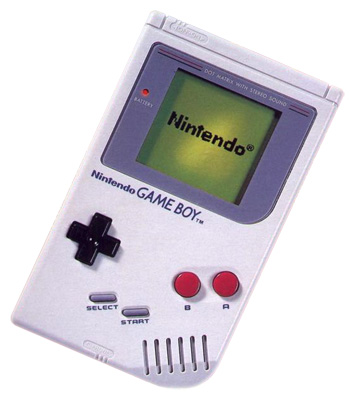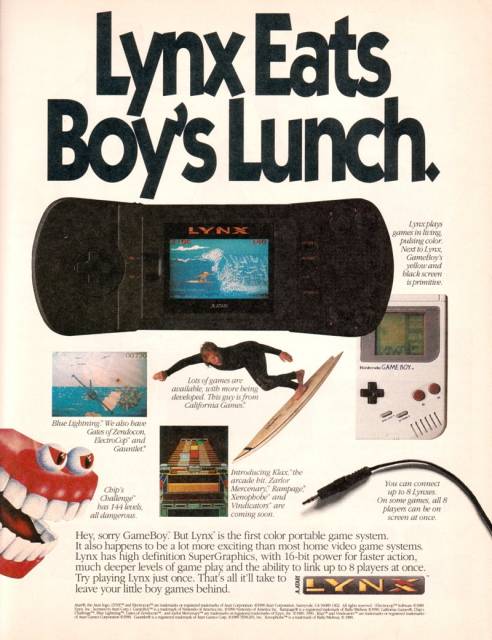Overview
 The Game Boy
The Game BoyThe Nintendo Game Boy was one of the first commercially viable handheld game systems on the market being released in 1989. The Game Boy was released in North America in August, 1989, in Japan on April 21, 1989, and in Europe in September 1990. The Game Boy was the first in the Game Boy line, a line that lasted over fifteen years until the release of the Nintendo DS. It was created by the brilliant Gunpei Yokoi, as well as the same team that had developed Nintendo's Game & Watch series. The Game Boy pack-in game was Tetris, a little known puzzle game from Russia that would help lead the Game Boy to its massive success. Minoru Arakawa and several employees from Nintendo of America went to Russia to sign a deal to get the game on their system, they saw it as the equivalent to packing in Super Mario Bros with the NES. Despite the Game Boy's handicap of being able to only display two colors, something that was technically inferior to what other handhelds was offering at the time it was massively more successful. Part of this was due to the fact that the batteries for Game Boy lasted a significantly longer times than those used for other full color handhelds, due to the fact that it used four AA batteries. 1998 saw Nintendo introduce the Game Boy's successor the Game Boy Color; the two systems games were actually compatible with each other, with the entire Game Boy line up playable on the Game Boy Color and a select few Game Boy Color titles playable on the original Game Boy (although not in color). Backwards compatibility became a stable of Nintendo handhelds, Game Boy classic games were playable up until the release of the Nintendo DS.
In 1994 Nintendo released an adapter for the Super Nintendo entitled the Super Game Boy, which allowed Super Nintendo players to play Game Boy games on their TV with a limited amount of colors. The adapter did not require the owner to own the original Game Boy system, just the adapter; despite this Game Boy remained as popular as ever. The first variation of the Game Boy, the Game Boy Pocket arrived in 1996. It was slimmer, more compact and the first in what would become a Nintendo tradition of releasing multiple variations of their handhelds. The Game Boy managed to sell its shipment of a million units within weeks in the United States and its initial shipment of 300,000 units in Japan in two weeks and reached 500,000 sales in Japan by July. The Game Boy and the color has sold 118.69 million combined worldwide and the Game Boy had sold 66.42 million alone before the release of the color. Twenty years after its introduction, in 2009 the Game Boy was inducted into the Nintendo toy hall of fame.
Competition
 An ad for the Atari Lynx that portrays the Gameboy as underpowered.
An ad for the Atari Lynx that portrays the Gameboy as underpowered.When it launched in 1989, the Game Boy entered a handheld battle against the Atari Lynx and Sega Game Gear. Both the Lynx and Game Gear were technologically impressive for the time. They featured full color backlit screens and, in the case of the Lynx, significantly more processing power. Atari and Sega attempted to capitalize on their products' capabilites in advertisements that portrayed the Game Boy as weak and childish. A memorable Sega ad from the time proclaimed that "The Sega Game Gear separates the men from the boys". Despite their marketing efforts, the Lynx and Game Gear could not stop the Game Boy's dominance. Their weak battery life (a Game Gear or Lynx could deplete six AA batteries in 4-6 hours), combined with lackluster software libraries and higher prices, proved fatal.
Hardware Revisions
There was three different versions of the Game Boy that was released during its life. The Game Boy Light however was only released in Japan.
Game Boy
 Game Boy Classic
Game Boy ClassicThe Game Boy was released on April 21, 1989 in Japan and then later in August for North America. The classic Game Boy ran on 4 AA batteries which powered the system for around 35 hours. Despite its size and less than perfect monochromatic screen the Game Boy lasted seven years until it received its first update. The Game Boy was only available in grey, in 1995 a "Play it Loud" line of the handheld was available in red, green, black, yellow, blue, white and transparent though this line had the exact same specifications. This set a trend of Nintendo handheld's being released in multiple colours. The link cable port is larger than the rest of the Game Boy line which makes it unable to link with all future models of the Game Boy.
RAM: 8 kB internal S-RAM
- Video RAM: 8 kB internal
- ROM: 8 Mb cartridges
- Sound: 2 Square Waves, 1 programmable 32-sample 4-bit PCM Wave, 1 White noise, and one audio input from the cartridge.
- Display: Reflective LCD 160 x 144 pixels
- Screen Size: 66 mm (2.6 in) diagonal
- Power: 4 AA Batteries
- Dimensions: 148 x 89 x 32 mm
- Weight: 394g (with batteries)
Game Boy Pocket
 Game Boy Pocket
Game Boy PocketThe Game Boy Pocket was originally released July 21, 1996 in Japan and then later released in North America in September 3, 1996. The Game Boy Pocket was smaller, lighter version of the original Game Boy designed to be able to easily fit in your pocket. An additional plus point of the system was that it only needed 2 AAA batteries, though this only powered the system for 10 hours. The Pocket featured a re-designed smaller link port, this version of the port was later used for all later models in the Game Boy line. Another improvement was an improved monochrome screen which did not blur up like on the original. The Game Boy Pocket like the original had no blacklight for darkened area and the first run did not feature a LED to indicate power levels, though due to public outcry a LED was added. The Pocket has been released in silver/chrome, red, yellow, green, black, transparent, pink and the original grey. Some limited editions of the handheld were also released.
- CPU: Custom 8-bit Sharp LR35902 core at 4.19 MHz
- RAM: 8 kB internal S-RAM
- Video RAM: 8 kB internal
- ROM: 8 Mb cartridges
- Sound: 2 Square Waves, 1 programmable 32-sample 4-bit PCM Wave, 1 White noise, and one audio input from the cartridge.
- Display: Reflective LCD 160 x 144 pixels
- Screen Size: 66 mm (2.6 in) diagonal
- Power Supply: 2 AAA Batteries
- Dimensions: 124 x 76 x 23 mm
- Weight: 148g (with batteries)
Game Boy Light
 Game Boy Light
Game Boy LightThe Game Boy Light was a Japan exclusive variation of the handheld that was released on April 14, 1998, due to its Japan only release it is one of the rarest Game Boy models. The main selling point was it's indigo coloured backlight that allowed for play in dark environments. The Light ran on two AA batteries and lasted for 20 hours with the light off and 12 with it on. Amazingly none of the consoles that followed the Game Boy Light featured a back lit screen until the 2003 release of the Game Boy Advance SP. The Game Boy Light was only available in Gold and Silver though numerous special editions were released. The Game Boy Light was never released outside of Japan due to the imminent release of the Game Boy Color and Japanese thinking that western gamers wanted color not light.
- CPU: Custom 8-bit Sharp LR35902 core at 4.19 MHz
- RAM: 8 kB internal S-RAM
- Video RAM: 8 kB internal
- ROM: 8 Mb cartridges
- Sound: Mono
- Display: LCD (Passive, monochrome, backlit) 160 x 144 pixels
- Screen Size: 2.56 inches
- Power Supply: 2 AA Batteries
Launch Titles
Japan
North America
Europe
Features
 A Game Boy cartridge
A Game Boy cartridgeThe Game Boy's control was very similar to that of the original Nintendo Entertainment System. It had a D-pad, A and B buttons, and a Select and Start button. On the side of the Game Boy was a volume control, a contrast control, a link cable port, and a jack for rechargeable batteries (instead of just the regular batteries). There was a sliding on-off switch on the top of the handheld a slot for the cartridges, the classic Game Boy cartridges are usable in the entire Game Boy line. The link cable port could also be used for the Game Boy Printer. The link cable was originally designed to allow for head to head multiplayer though Satoshi Tajiri's wildly successful pokemon series revolutionised multiplayer handheld gaming with its focus on trading rather than competitive multiplayer.
Top Ten Best Selling Games
- Tetris (35 Million) *Bundled with the system.
- Pokemon Red/Blue/Green (20.68 Million Approx)
- Super Mario Land (18.06 Million)
- Super Mario Land 2: 6 Golden Coins (11.09 Million)
- Pokemon Yellow (8.86 Million Approx)
- The Legend of Zelda: Link's Awakening (6.05 Million Approx)
- Dr Mario (2.08 Million)
- Super Mario Land 3: Wario Land (1.59 Million Approx)
- Kirby's Dream Land 2 (1.49 Million Approx)
- Kirby's Dream Land (1.45 Approx)
Accessories
Game Link Cable
The game link cable allows for interaction between multiple Game Boy's in certain games. Originally designed for the multiplayer battle mode in Tetris, its most popular use was the transferring of data in pokemon. The game link cable for the original Game Boy was not compatible with any future variations of the Game Boy without the use of the adapter.
Game Boy Printer
The Game Boy printer was released in 1998, it was compatible with the Game Boy, Pocket, Color and Advance. It is designed to work in conjunction with the Game Boy Camera, though some Game Boy and GBC games were also usable. It needs 6 AA batteries to run and uses special 3.8 cm Game Boy printer paper.
Game Boy Camera
 Game Boy Camera
Game Boy CameraIn 1998 Nintendo released the Game Boy camera, it was compatible with the Game Boy, Color, Pocket and Advance. The camera could only take black and white pictures and when used in conjunction with the game boy printer you could print your pictures out. The Game Boy camera was aimed at children who could not afford their own camera, the Camera also had some special features and mini-games to play. The Game Boy Camera was launched in five different colors blue, green, red, yellow and clear purple. There was also some limited editions released such as The Legend of Zelda and Pokemon editions.
Super Game Boy
Nintendo released the Super Game Boy accessory in 1994 for $60. The Super Game Boy allows Game Boy games to be played on your TV screen by using it with your Super Nintendo. It was also compatible with Game Boy Color cartridges, any original Game Boy cartridges you played with your Super Game Boy would still be in black and white, though some later games were programmed to show up in color and display a border around the game.
Log in to comment